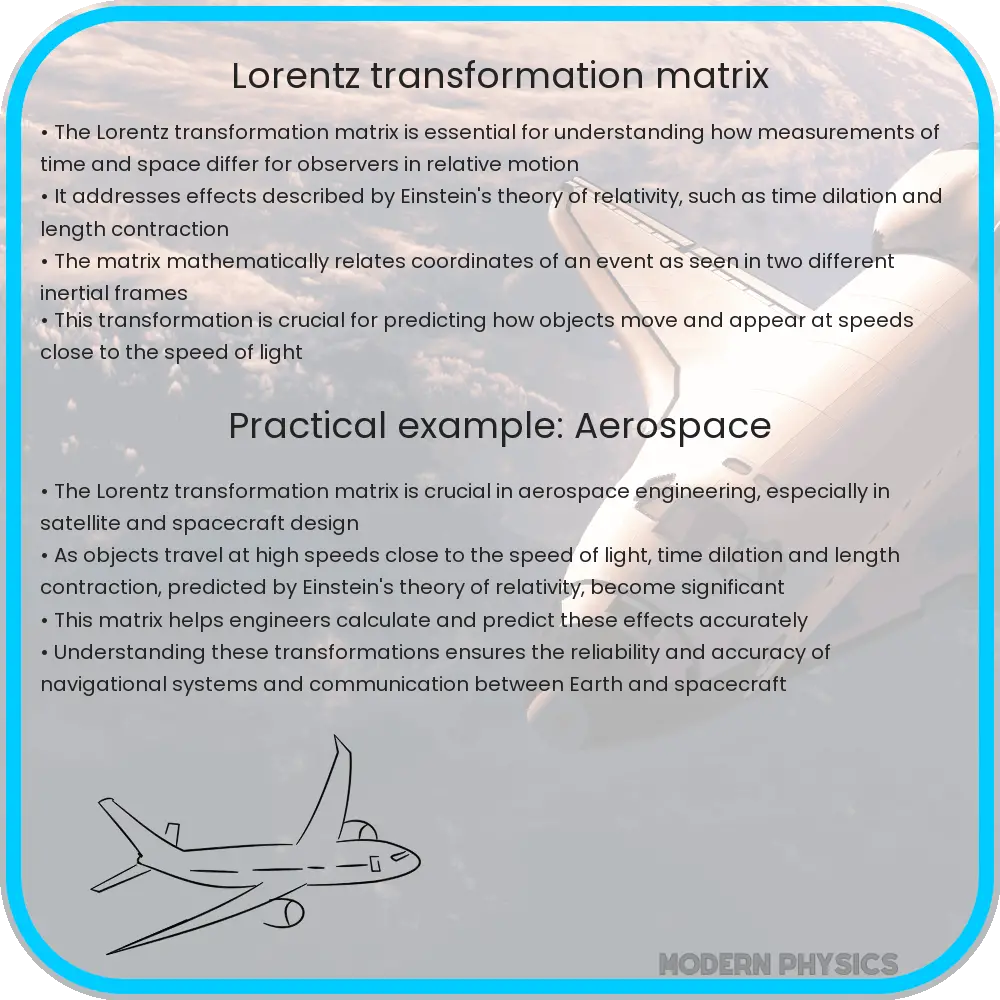A foundational concept in special relativity, the Lorentz Transformation Matrix mathematically relates space and time coordinates across different inertial frames, essential for understanding measurements of time dilation and length contraction.

Understanding Lorentz Transformation Matrix in Special Relativity
One of the most groundbreaking ideas in physics is the theory of special relativity, introduced by Albert Einstein in 1905. At the core of this theory lies the concept that the laws of physics are the same for all non-accelerating observers, and that the speed of light in a vacuum is constant, regardless of the motion of the light source. From these postulates, surprising phenomena such as time dilation and length contraction arise, which can be mathematically described by the Lorentz transformation.
The Lorentz Transformation Matrix
The Lorentz transformation is a set of equations that relate the space and time coordinates of one inertial frame to another, assuming that the two frames are moving at a constant velocity relative to each other and that they align with the direction of motion. The transformation is crucial for understanding how measurements of space and time by different observers are related to each other.
The Lorentz transformation matrix for motion along the x-axis is given by:
| γ -βγ 0 0 |
| -βγ γ 0 0 |
| 0 0 1 0 |
| 0 0 0 1 |
Where:
- γ (gamma) is the Lorentz factor, defined as γ = 1 / sqrt(1 – β2),
- β (beta) is the velocity v of the moving frame relative to the speed of light c, expressed as β = v / c.
Time Dilation
Time dilation is a phenomenon predicted by the Lorentz transformation indicating that time as measured in a moving frame of reference will always be longer compared to the time measured in a stationary frame of reference. This effect becomes more significant as the relative velocity approaches the speed of light.
Mathematically, it can be expressed as:
Δt’ = γ * Δt
where Δt is the time interval measured in the stationary frame, and Δt’ is the time interval measured in the moving frame.
Length Contraction
Conversely, length contraction occurs in the direction of motion. Objects measured in a moving frame of reference will appear shorter compared to their length in a stationary frame of reference. This effect also becomes more notable as the relative velocity increases.
The formula for length contraction is:
L’ = L / γ
where L is the original length measured in the stationary frame and L’ is the length measured in the moving frame.
Both time dilation and length contraction are not merely mathematical curiosities; they have real-world implications and have been confirmed by various experiments, such as those involving particles moving at high speeds in particle accelerators.
Understanding the Lorentz transformation and its consequences helps bridge the gap between classical physics’ concepts of absolute time and space and the modern understanding led by relativistic physics. This knowledge not only deepens our comprehension of the universe but also aids in the advancement of technologies that rely on the principles of relativity, such as GPS satellites and other high-velocity systems.
Continuing this exploration, we’ll delve deeper into the implications of the Lorentz transformation in the next sections, examining its application in modern physics and technology.
Applications in Modern Physics and Technology
The principles of the Lorentz Transformation are not just theoretical; they play a crucial role in the functioning of many modern technologies. For example, the Global Positioning System (GPS), which is used for navigation around the globe, must account for the effects predicted by relativity to maintain accuracy. The high speeds of the satellites and the slight but significant difference in the gravitational field compared to Earth’s surface mean that both special and general relativity are considered to correct the satellite clocks.
Moreover, understanding special relativity has been pivotal in the fields of particle physics and cosmology. Particle accelerators, like the Large Hadron Collider (LHC), routinely accelerate particles to near the speed of light. At these extreme speeds, the mass of particles increases according to relativistic principles, and designing these accelerators requires precise knowledge of the Lorentz transformations to ensure accurate results in experiments probing the fundamental components of matter.
Challenges and Perspectives
While the Lorentz Transformation provides a robust framework for modern physics, it also presents challenges, especially when attempting to reconcile it with the laws of quantum mechanics in areas like quantum field theory and string theory. These advanced topics seek a unified understanding of the fundamental forces of nature, currently described separately by theories operating under different frameworks (general relativity for gravity and quantum mechanics for electromagnetic, weak, and strong interactions).
The study of special relativity continues to evolve, pushing the boundaries of how we understand time and space. There is ongoing research aimed at testing the limits of this theory under more extreme conditions, and its validity remains a critical topic in theoretical physics.
Conclusion
The Lorentz Transformation, a pillar of Einstein’s special relativity, extends far beyond theoretical interest and forms the backbone of many modern technological and scientific undertakings. From enabling precise global positioning systems to allowing for the explorations at large particle colliders, the practical applications of this sophisticated mathematical transformation highlight the profound influence of Einstein’s ideas on our daily lives and the functioning of technology.
As we continue to explore and validate the principles of special relativity through advanced experiments and applications, our understanding of the universe becomes increasingly precise. This ongoing journey not only deepens our knowledge of physics but also continuously revamps our technological capabilities, demonstrating the indispensable role of fundamental science in progressive innovation.
